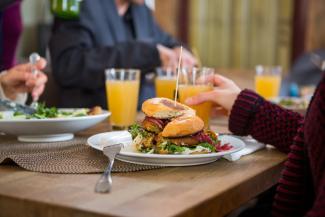
Everything you eat is converted to sugar – yes, proteins and fats, too. A fast food meal spikes blood sugar by 30%. Nutritionist Kohila Govindaraju tells you how to break out of the vicious cycle of sugar rush, insulin spike, blood sugar drop, renewed hunger and weight gain.
Go for the slow burn
If you want your day to be more productive and rewarding, launch it with a nourishing meal. You will be more productive all day long if you invest just a few minutes in eating a healthy breakfast. A healthy breakfast sets the tone for the rest of the day!
Hot cereal or granola or an egg omelette with toast will jump-start the brain, fire up the metabolism and give you energy that lasts till midday! But not all food is created equal.
Foods burn at different speeds. Swap that granola with a sugary cereal and soda and you have a problem. Sugary foods burn up faster than food packed with little fat and protein, making you tired and hungry soon after.
Everything you eat impacts your insulin level. Do you know that more than any other hormones in our body our diet is key in regulating the insulin level? Everything you eat is converted to sugar. Yes... the carbohydrates, the fats, the proteins... are converted to glucose that ends up in your blood, travelling around the body, no matter where they come from your meal!
So, what happens when you give in to temptation and chow down on ‘fast food’? Fast foods are a complete package of fats, calories and sodium that sends your blood sugar soaring! Do you know that fast food meals spike blood sugar levels by 30% even in a healthy person? An average hamburger size in the early ’60s was just 1.5 oz/42.5g but today it is more than 8 oz/227g! Can you imagine the sugar rush?
The regular sodas and juices in this package are loaded with sugars and your body doesn’t need so much.
Your body is unprepared for this sudden sugar rush, and it has to release a massive amount of insulin all at once to deal with the rise in blood sugar. High spike in insulin leads to a dramatic drop in blood glucose, which causes your body to feel hungry again.
What next? You eat more food since you are hungry and the cycle repeats. The additional problem is that the frequent sugar rush and insulin spikes can lead to mood swings, constipation and lower energy levels. Ultimately it can worsen the diabetes condition and promote weight gain. In addition to this vicious cycle, the huge amount of sodium that is hidden in the food will increase your blood pressure, too!
So what you’ve got is sugar rush, insulin spike, high blood pressure, weight gain!
Pair your carb with the right partner
What you eat with your carbohydrate also matters. Sugar level rises about 15 to 20 minutes after you eat. But if your meal comprises quickly digested carbs like white bread, white rice, candy, soda and juice, it peaks instantly.
If your meal is well balanced with complex carbohydrates, protein, fats and fiber, blood sugar tends to peak about one to two hours after eating. Protein and fats tend to slow down the absorption of glucose. A bowl of rice with beans or lean meat and vegetables will naturally reduce the blood sugar impact of the whole meal! Beans are digested slowly, hence the small impact. You can enjoy your dessert too, as long as it is a part of a healthy meal plan that is combined with exercise.
So, you need to be mindful of portion sizes, the quality of the carbohydrates, proteins and high fat add-ons like salad dressings, sauces and cheese.
Eat whole foods, not refined
It is wise to stay away from high Glycaemic Index (GI) foods. White rice, white bread, baked potato, rice cracker, rice cakes, breakfast cereals, scones, cakes, donuts made of refined flour, sugary drinks are few of the high GI foods. (Glycaemic Index refers to the effect a food has on a person’s blood sugar level. A high GI food raises blood glucose more than a medium or low GI food.).
Related Reading
Do's and Don'ts of a Diet for Diabetes
Eat less refined carbohydrates and more whole foods like apple, plum, beans, lentils, barley, whole meal bread, peanut butter, oats, nuts, all brans, unprocessed brans.
Asian noodles like Jade noodles, soba noodles and shirataki noodles are also low in GI.
Eating meals at regular intervals will also help to keep the blood sugar well balanced.






